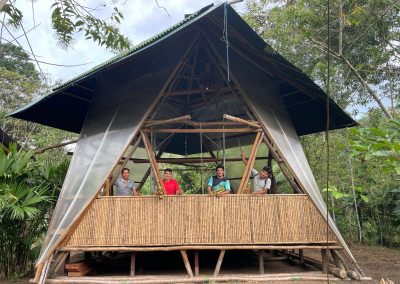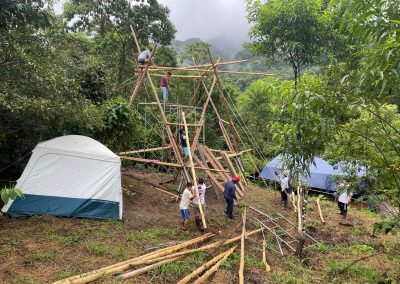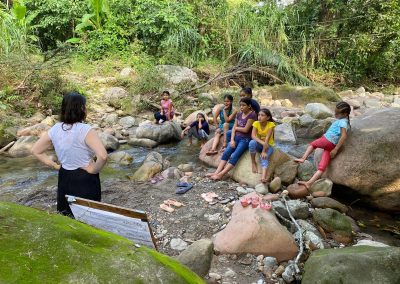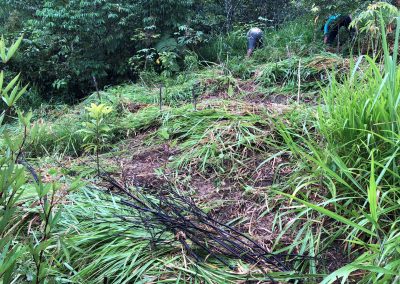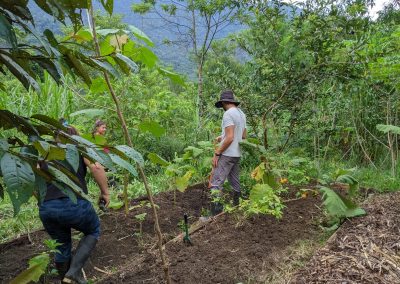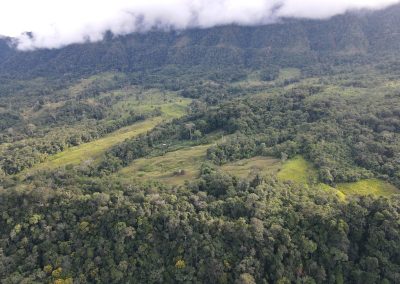Finding home in a tropical cloud forest
In early March 2020 a group of MA Ecological Design Thinking students set off to Peru to work on a nature-based educational project that was being set up there by a former student at Schumacher College. As the global pandemic struck, those students were faced with a dilemma: should they stay on or return home? In this interview we speak to one of those students, George Heibel, who chose to stay on and who, upon finding a deep sense of belonging and purpose in the cloud forests above the Amazon, continues to live and work out there two years later. Interview by Will Kemp, transcribed from the audio conversation below.

Schumacher College alumni from 2018, 2019 and 2020, and core team members at Siendo Naturaleza.
WK: Can you tell us a bit about the experience of studying Ecological Design Thinking at Schumacher College?
GH: It’s always a bit of a hard thing to put into words, and it’s hard to kind of summarize but I suppose what I always come back to is that I came with certain expectations, with a certain technical background, a background in architecture, and my understanding of ecological design was designing green sewage systems and other highly technical systems. And at first I found myself a bit frustrated wondering why we were talking so much about Gaia. But little by little, I started understanding that that’s really what I needed in order to develop my path through my career. Without that underlying social aspect, and you might say, a kind of spiritual aspect, asking why and what the purpose of doing regenerative or ecologically based work is, then why even do it?
Without that I think I would still be kind of missing something that I really hold dear in the work we do now.
WK: That’s fascinating. So then as part of the course, you did a final project or placement out in Peru. I’d be interested to hear more about that.
GH: Yeah. It’s now become kind of the main thing I’m doing in my life right now. So, it started with a previous alumni Elaine Cohen who came and invited our cohort. She was on the previous year of the MA Ecological Design Thinking, and came to us if you like as our older sister to invite us to participate and put what we’ve been learning into practice with her life project. And so she came to the College, made a really beautiful invitation with one of her other colleagues, Carolina, from Brazil.
We had a series of long conversations, asking: is it appropriate for a bunch of Europeans to go to South America and do this kind of work? And that in itself was a whole beautiful process of understanding what ecological design is on another level, really being faced with the global question of how do we put this into practice.
And the financial aspect was another thing. The College wasn’t in a position to send us all to the other side of the world. So it was an interesting learning experience in and of itself. We came together, developed a fundraising campaign, and raised a couple of thousand pounds to get us there. And that was a nice way to kind of explain what we were doing to our families and friends and network. And it was really good to see the kind of support that everyone in their networks got. It turned out to be a pretty wide network with I think maybe around a hundred individual donors in the end.
We finished our last project here in person and then we packed up in March of 2020 with the intention of returning in three weeks. So yeah, we went all together all 13 of us, including Roberto Fraquelli – who was programme lead for Ecological Design Thinking at the time – and it was really nice though hard to put into words.
WK: But it inspired you in some way. You’ve stayed there and really committed to being out there now…
GH: Yeah, for a number of reasons. I don’t know, I’m reflecting on this for the first time today on what’s appropriate to mention, but I kind of landed in this really beautiful place where the project is based in Peru. It’s in the highlands of the Amazon jungle, where the Andes meet the Amazon basin. It’s a very particular, very, very biodiverse area and I was immediately struck by how beautiful it was. It’s an incredible place and so very quickly I felt comfortable there. I’ve been made fun of as George of the Jungle for my entire life, so I think I just leant into that.
So there was a period of getting to know the community including a series of meetings with leading members of the community, going to meet some of the kids in the communal field, playing a bit of sport, you know, as foreigners coming in. And the people there are incredibly generous, they’re very welcoming and we found a really nice community feeling immediately.
We spent some time getting to know each other and then we formed our proposals for small projects. One group of students decided to do a small workshop with the kids, bringing a little bit of their own country to the community. We had one student with us who was from Japan who taught origami. Another one from India working with natural pigments and dyes. Everyone brought their own gifts. And we had this really beautiful day with about 20 kids from the area.
That was going very well and then the lockdown happened and it’s all kind of become a bit of a, I don’t know, not a legend exactly, but it’s still talked about. “The cohort that got stuck in Peru.” It became a whole big mess trying to get everyone home. And for some reason, I was never really in any sort of rush to go anywhere. It was clear, with the incoming lockdowns – the United States already had some lockdowns in place I think – that my prospects were either to go back to a kind of suburban setting where I knew I’d be locked in a house for an extended period, or have, you know, incredible almost infinite space and really important work that could be done. So I made the decision to stay there through the lockdown, for another month or so, thinking it would be over soon.
And at that point, a group of five Schumacher students spread across the year before me and myself all decided to stay and come together and support each other since it was a bit of a mess for anyone to leave.
So it turned into, what, six, eight months of all of us living together and working, building, setting up the foundations of the project as it exists today in Peru. At the same time I was writing my dissertation in a notebook by candlelight. It was a whole experience. But that was kind of the arc of the placement.
WK: That’s amazing. You just got stuck out there and then kind of had to be confronted with this choice, and choosing to stay.
GH: It felt right. And I felt called by the land to stay and work.
Images left to right: The construction team / Construction of housing / River Classroom / Regenerative agriculture research site / The team working in the gardens / The area around Siendo Naturaleza showing deforestation patterns
WK: Can you tell us a bit more about what the project has become today. What is it and how do people engage with it?
GH: So it’s still a very young project. It started at the beginning of the pandemic. The land based part is called Siendo Naturaleza, which in Spanish translates to “being nature” and at its core it’s a learning centre. And that core idea came from Eliana, who’s the founder. The short version is she’s from Peru originally, went to university in the United States and was called back at a certain point to return home and give back all of the privilege and the opportunities she’d had and just return some value to her homeland. And she, I think similar to me, fell in love with the area. As I’ve said, it’s a really beautiful place, with great people.
I don’t have the metrics off the top of my head, but Peru consistently ranks very low on international primary education rankings. And within Peru, the San Martín region where we are, is also very low on the charts, as it’s so rural. Peru is a centralized country, all of the resources come from and go to the capital and the provincial sites kind of get, you know, just a little bit of support. So Eliana saw an opportunity to go in and provide education and, especially in the times we’re living in, really focus on the ecological ethos that she learned at Schumacher College. It’s about developing nature connection and an understanding of how to behave appropriately in the world. Not that we’re going in and telling people how to behave appropriately, you know, we’re also learning. So it’s a place to be and investigate what it means to be a steward of the land and to act appropriately in the economy and in the environment. The educational efforts fall under two main spheres within our educational centre. First, we’re working with international students. At this point we’ve got around 22 Schumacher students, including my cohort and following years of the MA Ecological Design Thinking, coming to our centre and learning together, doing projects, investigating. And we’re also developing some partnerships with other universities in the US to see how we can provide a space for students to come and investigate and research in a series of different biological, ecological design and, hopefully someday, engineering projects. That’s one side. And on the other we have the local initiatives. As I mentioned, our cohort worked with a series of children in our area and that’s continuing. At this point we’ve done three other pilot programs and in October we’re starting our next one which will be the last pilot as we transition to a place where we really know what we’re doing supporting kids in the valley. So that’s a funded program for about 20 students.
WK: That’s really interesting. I like that point you made about it not being about us coming in and telling people what to do, and that what you’re trying to do is build community, find connections that are respectful of everyone’s perspective and experience, and all learning together. That sounds like a very “Schumacher College” thing.
GH: Yeah, it’s kind of the core of at least my understanding of ecological design. Ecological design is an emergent thing. You know, you can’t come in and say, this is the best way to farm, this is the best way to structure your local economy. It’s a conversation. And we very much hold onto that – we’re there as neighbours. And I think it’s really beautiful to start, little by little, to connect. For example, we go and play soccer on the weekends with everybody, we get invited to birthday parties, we have people over for coffee. And while we are there we have that conversation about how can we best live in this amazing place and care for this place together. We don’t know any more than anyone else knows, but I think we’ve been trained how to ask the right questions to maybe start approaching how best to inhabit the land.
Find out more about Siendo Naturaleza via this link.
Below is a video from the second student placement a year later.
MA Ecological Design Thinking is a one year Master’s programme at Schumacher College which starts in September each year. Find out more and apply via the button below.

